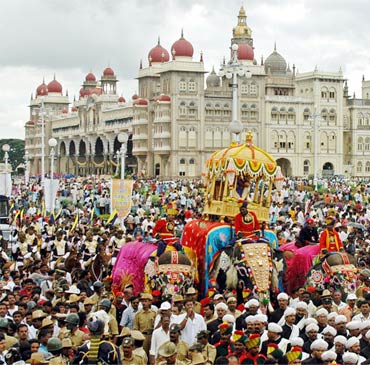
Want to see the pages of history come alive? Then plan a trip to Mysore this weekend. In fact there can't be a better excuse to pamper yourself with this break than Sunday's jamboo savari, says Shruti Indira Lakshminarayana.
Jamboo Savari is a procession that marks the end of the nine-day Dussehra festival in Mysore. The festival dates back to the Vijaynagar Empire and is held on Vijayadashmi, the day on which kings launched wars or expanded their territories. The Wadiyars who ruled Mysore brought the tradition to Mysore.
While durbars, cultural and sports events were and are still being held across nine days, the procession is the one that was and is held on a grand scale.
In those days the king would start Vijayadashmi Day by worshipping the royal sword and offering puja at the Bhuvaneshwari temple. He would then sit on the golden 'howdah' that is placed on an elephant and go on a procession. A 21 cannon salute marked the beginning of the event that culminated at Bannimantap where the present day torchlight parade is held.
After reaching Bannimantap, the king performed the Banni tree puja. It is believed that the Pandavas had hidden their arms here during their incognito life and also that it was from here that Arjuna had retrieved his bow Gandiva to defeat the Kauravas. Thus worshipping the tree before launching a war was important for the king.
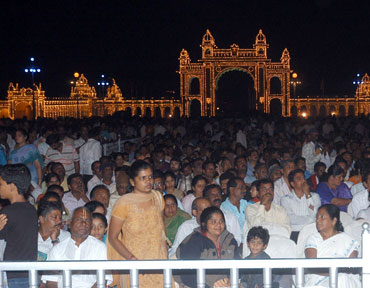
After the puja the king received a guard of honour from his soldiers and then watched the torchlight parade that ended with fireworks. The procession that included camels, horses, elephants, musicians and the army then returned to the palace. The king used to interact with people on his way and also distribute sweets and gifts to the needy.
Post 1969, Dussehra is being celebrated as a state festival by the government. Since then the route and compositions of the procession have changed.
The idol of Goddess Chamundeshwari is placed in the 'howdah'. The chief minister inaugurates the procession and the royal scion is invited to view the procession. After performing the Nandi Dwaja puja and seeking the blessings of Chamundeshwari, cannon shots are sounded and the procession begins from the palace premises.
The procession includes folk dance troupes, tableaux, music bands, elephants, horses and camels. Among the prominent participants is the police band. Set up in 1865 with the patronage of the kings and the British, the band was later handed over to the police department.
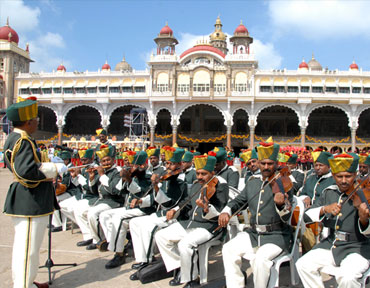
Adding star value to the procession are the elephants. The elephants are brought from forests around Mysore and on their entry into the city given a grand welcome. The mahouts and their families accompany them. On the procession day, the pachyderms are painted in vibrant hues. They are even decked up with jewellery.
Seating arrangements are made to witness the event in the palace and on the roads through which the procession passes.
Torchlight parade that takes place on the same evening marks the end of the festivities. In the past, the parade registered the participation of the king's military alone. It was held to show to enemies the strength of the ruling king's army.
Fireworks were a part of the programme and it was a huge hit with foreign visitors. Police, home guards, scouts and guides, army service corps among others participate.
A laser show on the history of Mysore, equestrian show, torch light show, motor cycle stunts, tent pegging, march pasts and fire works are the other annual features.
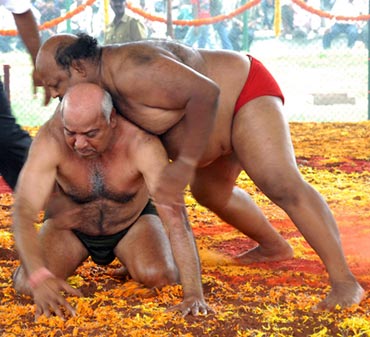
While the October 17 events are not something you should miss, the best way to soak in the Dussehra spirit is by landing in the city two- three days early. You could start your day by witnessing cultural, literary and sporting events that give you a sneak peak into the rich heritage of the state.
The traditional wrestling matches, for instance, are a must-see. For fitness freaks cycling trips have been organised. Film buffs are also in for a treat as some of the most acclaimed local and international films are screened.
Theatre enthusiasts will also have their hands full for several amateur college and professional troupes will stage plays in theatre repertoire Rangayana. The city also hosts several classical dance and music performances and for a truly royal experience attend those given at the palace premises.
Wanting to make this a memorable outing for the young ones, Makkala (Children's Dussehra) Dussehra is also held. Entertainment and talent shows targeting kids are held.
There is something called Raitha Dussehra for the farmer in you. Latest farming technologies and information regarding viable crops is made available as part of this event.
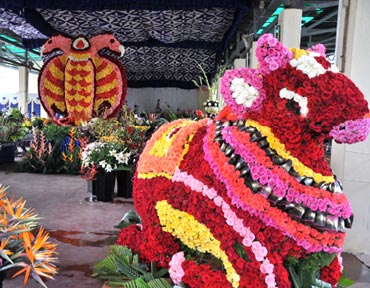
Flower Shows that takes place at the Curzon Park is another must-see. Fruit, vegetable carvings and flower arrangements here are sight to behold. This year's main attraction is the floral version of Gandaberunda, the Mysore royal family motif.
The annual consumer exhibition held in Dodkere Maidan also makes for a good family outing. While youngsters will enjoy the joy rides, shopaholics can indulge themselves by buying goods from across the country that are sold here. Several government departments would have also set up stalls to provide information on their projects and works.
The main attraction here this year though, is a replica of the Taj Mahal. The structure has been put up at a cost of Rs 80 lakhs.
Foodies also have a wide platter to choose from, just not at the exhibition but also at the Food Mela. In fact the Food Mela is a good place to savor delicacies from across the state.
While there, don't forget to feast on Mysore's specialty Mysore Pak. Also as part of the festival, 65 hotels are offering sumptuous and Dussehra special Mysore thalis at Rs 20.
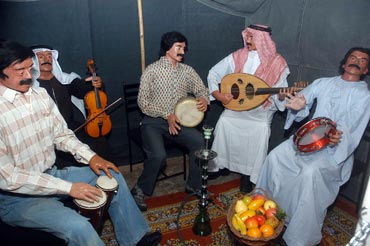
Driving through the city is another good option as lit up prominent roads, government and private establishments, shops and houses make for picture perfect scenes. Tonga rides during the day are also recommended.
Do take a look at the dolls displayed publicly as part of the Gombe Habba (Doll festival) as well. Rangayana and Ramsons Art Gallery display traditional and contemporary dolls.
Another attraction this year is the wax museum that displays musical instruments and famous musicians. The museum is located on Viharamarga, Siddharta Layout.
The conduct of the popular air show however has been given a miss this year. If you still have time on hand visit Chamundi Hills, Temple town Srirangapatna or the neighboring Coorg.
All in all if it is a one state many worlds experience you are looking for then head to Mysore this weekend.